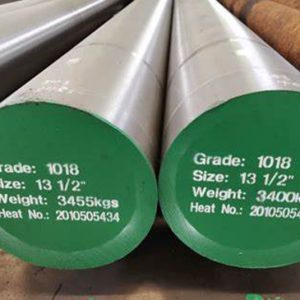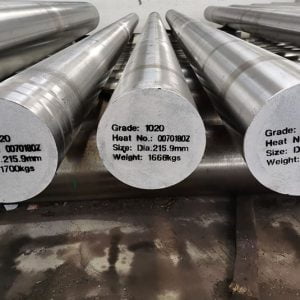Introduction
1018 steel is a popular low-carbon steel that is widely used in various industrial applications due to its excellent mechanical properties and ease of fabrication. Understanding the material properties of 1018 steel is crucial for engineers, manufacturers, and anyone involved in material selection and design. This comprehensive guide will delve into the top 1018 steel material properties, including its chemical composition, mechanical characteristics, physical properties, and common applications. By the end of this article, you will have a thorough understanding of what makes 1018 steel a preferred choice in many industries.
Chemical Composition of 1018 Steel

Key Elements
1018 steel is primarily composed of iron, with carbon as the main alloying element. It also contains trace amounts of other elements that enhance its properties.
- Carbon (C): 0.15% – 0.20%
- Manganese (Mn): 0.60% – 0.90%
- Phosphorus (P): ≤ 0.040%
- Sulfur (S): ≤ 0.050%
These elements contribute to the steel’s overall performance, affecting properties such as hardness, strength, and machinability.
Impact on Material Properties
The specific combination of elements in 1018 steel results in a material that balances ductility, strength, and ease of machining. The low carbon content ensures good weldability and formability, while the manganese improves tensile strength and hardness.
Mechanical Properties of 1018 Steel
Tensile Strength
Tensile strength is a critical property for materials used in load-bearing applications. 1018 steel exhibits good tensile strength, making it suitable for structural components and machinery parts.
- Tensile Strength: Approximately 440 MPa (64,000 psi)
Yield Strength
Yield strength measures the stress at which a material begins to deform plastically. 1018 steel has a moderate yield strength, providing a balance between strength and ductility.
- Yield Strength: Approximately 370 MPa (53,700 psi)
Hardness
The hardness of 1018 steel is another important property, particularly for applications involving wear resistance and surface durability. The material can be hardened through various heat treatments.
- Brinell Hardness: Approximately 126 HB
Ductility
Ductility refers to the material’s ability to undergo significant plastic deformation before rupture. 1018 steel has excellent ductility, making it easy to form and shape.
- Elongation: Approximately 15% in 50 mm
Toughness
Toughness is the ability of a material to absorb energy and plastically deform without fracturing. 1018 steel’s toughness makes it suitable for impact-resistant applications.
- Impact Toughness: Good (qualitative measure)
Table: Comparison of Key 1018 Steel Material Properties
| Property | Value | Description |
|---|---|---|
| Carbon Content | 0.15% – 0.20% | Low carbon content for good weldability and formability |
| Tensile Strength | 440 MPa (64,000 psi) | High tensile strength suitable for load-bearing applications |
| Yield Strength | 370 MPa (53,700 psi) | Moderate yield strength for balanced performance |
| Brinell Hardness | 126 HB | Moderate hardness for wear resistance |
| Elongation | 15% in 50 mm | High ductility for easy forming and shaping |
| Impact Toughness | Good | Suitable for impact-resistant applications |
Physical Properties of 1018 Steel
Density
Density is a fundamental physical property that influences the weight and mass of a material. The density of 1018 steel is typical of low-carbon steels.
- Density: 7.87 g/cm³ (0.284 lb/in³)
Thermal Conductivity
Thermal conductivity measures a material’s ability to conduct heat. 1018 steel has moderate thermal conductivity, which is important for applications involving heat transfer.
- Thermal Conductivity: Approximately 51.9 W/m·K
Electrical Conductivity
Electrical conductivity is the measure of a material’s ability to conduct an electric current. While not highly conductive, 1018 steel’s electrical conductivity is adequate for general applications.
- Electrical Conductivity: Approximately 6.9% IACS (International Annealed Copper Standard)
Melting Point
The melting point is the temperature at which a material transitions from solid to liquid. Knowing the melting point of 1018 steel is essential for processes involving heat treatment and welding.
- Melting Point: Approximately 1425-1460°C (2597-2660°F)
Applications of 1018 Steel

Automotive Industry
1018 steel is widely used in the automotive industry for various components due to its excellent machinability and balance of strength and ductility. Common applications include:
- Axles: High strength and toughness make it ideal for axles.
- Shafts: Good machinability allows for precise manufacturing of shafts.
- Pins and Rods: Adequate ductility and toughness for various pin and rod applications.
Construction Industry
In the construction industry, 1018 steel is used for structural components that require a good balance of strength, weldability, and cost-effectiveness. Applications include:
- Beams and Columns: Suitable for structural support elements.
- Rebar: Commonly used in reinforced concrete structures.
- Fasteners: Bolts and nuts made from 1018 steel are widely used.
Manufacturing Industry
The manufacturing industry benefits from 1018 steel’s properties for creating machinery and equipment parts. Key applications include:
- Gears: Adequate hardness and strength for gear applications.
- Tooling Components: Good machinability for making dies and molds.
- Machinery Parts: Versatile material for various machinery components.
DIY and Home Improvement
For DIY enthusiasts and home improvement projects, 1018 steel is a popular choice due to its ease of use and availability. Common applications include:
- Brackets and Supports: Used for making custom brackets and supports.
- Furniture Frames: Suitable for metal furniture frames and structures.
- Garden Tools: Good material for garden tool components.
Conclusion
1018 steel is a versatile and widely used material known for its excellent balance of mechanical properties, ease of machining, and good weldability. Understanding the material properties of 1018 steel, such as its tensile strength, hardness, ductility, and thermal conductivity, is crucial for selecting the right material for various applications. Whether you are in the automotive, construction, manufacturing industry, or a DIY enthusiast, 1018 steel offers reliable performance and cost-effectiveness.
FAQ
What are the primary 1018 steel material properties?
1018 steel material properties include tensile strength, yield strength, hardness, ductility, toughness, density, thermal conductivity, and electrical conductivity. These properties make it suitable for a variety of industrial applications.
How does the carbon content affect 1018 steel material properties?
The carbon content in 1018 steel, which ranges from 0.15% to 0.20%, plays a crucial role in its material properties. It provides a good balance of strength and ductility while maintaining excellent weldability and machinability.
What mechanical properties are significant in 1018 steel material properties?
Key mechanical properties in 1018 steel material properties include tensile strength (approximately 440 MPa), yield strength (approximately 370 MPa), and Brinell hardness (around 126 HB). These properties ensure the material’s performance in various applications.
How do the physical properties of 1018 steel material properties impact its usage?
The physical properties of 1018 steel, such as density (7.87 g/cm³) and thermal conductivity (approximately 51.9 W/m·K), impact its usage by providing the necessary balance of weight, heat dissipation, and structural integrity for different applications.
Why is ductility an important factor in 1018 steel material properties?
Ductility is a critical factor in 1018 steel material properties as it allows the material to be stretched or deformed without breaking. This property is essential for forming and shaping processes in manufacturing and construction.
How does toughness contribute to 1018 steel material properties?
Toughness in 1018 steel material properties ensures the material can absorb energy and withstand impact without fracturing. This makes it ideal for applications requiring impact resistance and durability.
How does manganese enhance 1018 steel material properties?
Manganese in 1018 steel, ranging from 0.60% to 0.90%, enhances the material properties by increasing tensile strength and hardness. It also improves wear resistance and machinability, contributing to the overall performance of the steel.
What makes 1018 steel material properties suitable for automotive applications?
The combination of strength, ductility, and machinability in 1018 steel material properties makes it suitable for automotive applications, such as axles, shafts, and pins, where these properties are essential for performance and reliability.
How do 1018 steel material properties benefit the construction industry?
1018 steel material properties, including good weldability and balanced mechanical properties, benefit the construction industry by providing reliable materials for structural components like beams, columns, and rebar.
What role does thermal conductivity play in 1018 steel material properties?
Thermal conductivity in 1018 steel material properties, approximately 51.9 W/m·K, ensures efficient heat transfer, making it suitable for applications involving heat dissipation, such as engine components and heat exchangers.





